Dreamhounds of Paris by DNA Cowboys
Embrace the Cosmic Hubris
Original SA post Dreamhounds of Paris: Embrace the Cosmic Hubris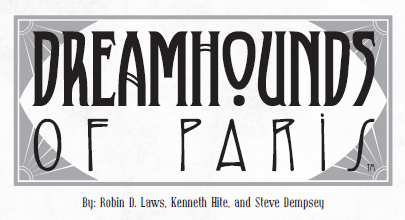
Welcome to Dreamhounds of Paris by Robin D. Laws with Kenneth Hite & Steve Dempsey. It's available through Pelgrane Press and the forbidden tome section of your local library.
This is a setting/campaign book for Trail of Cthulhu . I haven't played the game and don't own the core book, so this examination won't include much (if any) information about the mechanics. The setting info is full of enough great stuff, I hope you'll forgive the focus.
Dreamhounds of Paris posted:
Dreamhounds of Paris tells the never-before-revealed story of the Surrealist movement, and its involvement in a series of occult events bringing them into contact with a realm beyond our own. When they first discover it, they find it a realm of slightly precious wonder. As they explore it, and find themselves able to bend it to their unconvention wills and convention-shattering aesthetic, it becomes sinitser, modern, and contradictory--like the Surrealists themselves.
Although there are plenty of sidebars and asides to suggest alternate means of play, the default assumption is the PCs will be a historical gang of Surrealists selected from a list of pre-generated characters. The major events in these characters' waking lives are scripted to cleave as closely to history as players are willing to research: affairs, alliances, artistic coups, politics. However, once the PCs dream, they're thrust into a wild, ever-shifting world. Although it's left unclear whether the Dreamlands shape human dreams or are shaped by them--albeit slowly--the Surrealists are real powerhouses in the supernal realm. They draw upon their artistic instability to warp the Dreamlands. Each effect, no matter how minor, ripples outward until the realm is a particularly modern (cf. modernism) flavor of alienating and disorienting. The prescribed campaign arc goes something like this: PCs have amazing adventures in the Dreamlands, PCs mess up the Dreamlands, PCs try desperately to undo the harm they've created, PCs learn troubling truths about the human condition and the inevitable march toward fascism, war, and artistic prostitution.
What is Surrealism
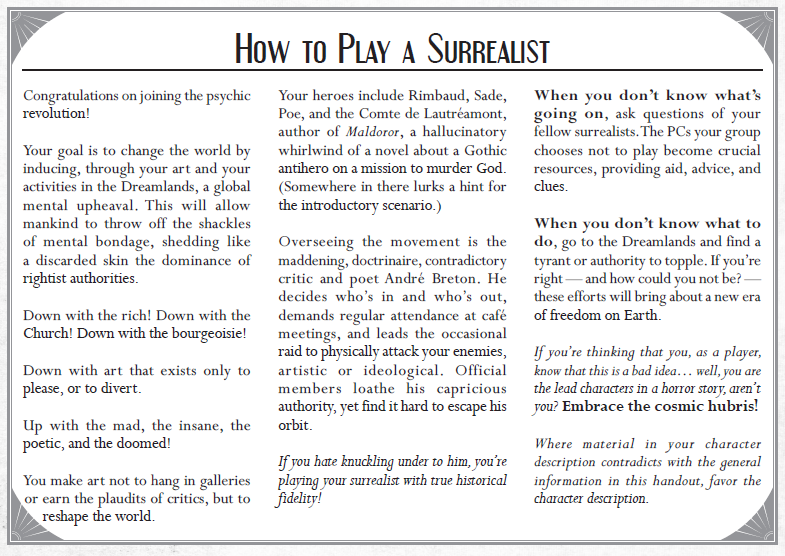
In Dreamhounds , Andre Breton is the undisputed king of Surrealism. He wrote the manifesto, he chairs all the meetings, and disagreeing with him (even on little matters) makes you lose Instability. Without Instability, you can't create art or influence the Dreamlands. Breton wields this power like a petty dictator, since he's unable to enter the Dreamlands himself. His attempts to codify and regulate surrealism have made him too clenched up to leave the physical plane. No matter how hard he tries, and what arcane rituals he dabbles in, he's unable to unmoor his spirit from his body. He's depicted as a tragic figure, but also a jerk and occasional antagonist.
Breton created Surrealism by piggybacking off of Dada. He combines multiple strains of modernist thought to create an artistic movement dedicated to shocking the bourgeois out of their comfortable assumptions. He seeks to overthrow the social order in favor of one that favors thinkers, unregulated artists, and other leftist Utopian ideals. There's also a fair degree of looking at pre-existing work and saying, "This is surrealism. So is this."
It's easy to read a lot of the Surrealist tactics as "freaking the mundanes" or what we see these days as the worst excesses of art school "big ideas" . There's some neat stuff in there too though, which I'm going to leave as an exercise for the reader. Dreamhounds takes the stance that most of the Surrealists were earnest in their desire to shock people through art and cause worldwide aesthetic and intellectual revolution, while still being starving French artists.
Timeline
Dada and Post-Dada: 1920-1922. Breton sets up a new movement, deposes Tristan Tzara.
Trance and Automatism: 1922-1925. Breton solidifies his movement while Surrealists experiment with automatic writing--a way to write while in trance. This is supposed to disconnect your mind from tradition, rational thought, and . Along the way, plenty of Surrealists find themselves able to access the Dreamlands.
The Radicalization: 1925-1928. Breton tries to connect the movement to Communism.
The Spanish Invasion: 1928-1936. Salvador Dali and Luis Bunuel hit the scene. Dali schemes to seize control from Breton.
Disintegration: 1937-1940. Pretty much everyone hates Breton by this point. War's coming, people are having rocky personal lives, and it's a bad time to be an artist, and let's all go insane.
Next Time: Dramatis Personae
Dramatis Personae 1
Original SA post Dreamhounds of Paris: Dramatis Personae 1Dreamhounds comes with nineteen pre-generated characters. They created using a few more points than standard Trail of Cthulhu characters to bribe players into selecting historical figures.
Each character is 1-2 pages of three-column text describing his or her Dreamhounds life from birth to death, including affairs and relationships with other prominent PCs. Each character also has game stats, a list of common artistic motifs, a drive, what they want from the Dreamlands, and a list of which of Breton’s rules they can break without risking Instability loss. Depending on the tone of the campaign, which is discussed by everyone at the start, these events can be background, guidelines, or iron fact. My guess is most groups will keep the character history up until the campaign’s starting date, at which point anything goes. The unchosen Surrealists, who become NPCs, will follow their lives as presented on their sheets, unless the GM has a more campaign-appropriate idea.
Anonin Artaud, The Revealed One: French poet, actor, and theatre director. Slowly goes insane from his excursions into the Dreamlands, where he seeks to protect humanity from unearthly forces by transforming them.
Georges Bataille, The Enemy Within: French nihilist artist. Brokers a deal with Nicolas Flamel, king of the Parisian ghouls, to prevent Andre Breton from physically traveling to the Dreamlands using a doorway in the catacombs. Travels the Dreamlands to prove his materialistic pessimism is correct.
Luis Bunuel, Two-Fisted Filmmaker: Spanish filmmaker. Macho filmmaker dedicated to attacking the outdated ideologies of the Church and the bourgeois. He uses the portal to the Dreamlands in the Parisian catacombs to film special effects that would be untenable in the waking world. His section includes a sidebar about the homophobic attitude of many of the Surrealists, along with an advisory that individual groups can treat this dynamic however they’d like.
Claude Cahun, Woman in the Mirror: French writer, artist. She travels the Dreamlands for images and objects to use in her work. Although lesbian, she isn’t shunned like the gay male Surrealists (“greeted more with incomprehension than contempt.”)
Lenora Carrington, Gothic Heroine: English painter. A collage by Max Ernst unlocks her forgotten dreams. Later, “his touch awakens your buried memories of adventures in a nighttime world of bizarre animals and Gothic hallways.” Later still, “Ernst leaves his wife for good--though she still sometimes ambushes the pair of you in cafes to pelt you with cups and saucers.” Her motifs include “weird animals, Gothic manors, green lakes, lunar surfaces, sexually fraught horses.”
Jean Cocteau, Resplendent Anathema: French artist, writer, theatre designer. Has an entire sidebar explaining “Why the Surrealists Hate Cocteau” (He’s gay, from a wealthy family, claims to have invented Surrealism, and jumps from cause to cause.) Encounters a manifestation of Cthulhu in the Dreamlands, which he writes into a children’s book ( Le Potomak ) to banish its fearsome power. Experiences unrequited longing for Pablo Picasso and Randolph Carter (met during WWI.) Explores the Dreamlands to stay off opium, find sexual adventure. Teams up with Giorgi de Chirico to expunge the Surrealist influence from the Dreamlands.
Salvador Dali, Cunning Visionary: Spanish artist. Early in life, he’s a dandy: “Together, you, Lorca and Bunel listen to jazz, drink rum, and call the squares putrefactos . The athletic Bunuel dishes out fistic retribution to anyone who makes fun of your outlandish attire and demeanor.” Later in life, he’s a wealthy dandy with a turbulent inner life marked with jealousy, family issues, and obsession. Overall, he’s arrogant, controlling, and unbalanced. Unlike many of the Surrealists, he has a modicum of business sense.
He clashes with Breton and tries to seize control of Surrealism--he’s the wild-eyed iconoclast and Breton is the rule-bound thug. Eventually, his popularity pushes him to turn his back on Surrealism: “Did you finally lose your Instability once and for all, or did you see something in the Dreamlands so horrible that you chose to throw it all away?”
Giorgio de Chirico, Remorseful Pioneer: Italian painter. The first to notice the changes he makes in the Dreamlands are warping it. He tries to combat it by returning to more traditional painting styles, but the new wave of Surrealists are already latching onto his transformative work and calling him an inspirational figure. He looks for redemption while the hardcore Surrealists turn on him for embracing the musty tradition of the past.
Robert Desnos, Dream Medium: French writer, painter, radioman. He’s a real dab hand at trance writing. Sometimes this gets him possessed by dream beings. Falls for Yvonne George, who doesn’t love him, but uses him for money and drugs. Falls for an unearthly starfish who takes the form of Yvonne George in the Dreamlands, who pretends to love him while eating away at his spirit. Behind a Fantomas revival in Paris, has eyes “the color of spoiled oysters.”
Marcel Duchamp, The Chess Player: French artist. Appears in the Dreamlands as himself and as his drag alter-ego Rrose Selavy--who eventually gains independent agency. Sees the Dreamlands as an intellectual puzzle and source of unexpected chess partners.
Paul Eluard, Lyric Revolutionary: French poet. He’s fans of collaboration, friendship, and Stalinism. He’s a fan of the “cause revolutions in the Dreamlands to encourage revolution on Earth” plan. Occasionally possessed.
Max Ernst, King of Birds: French artist, sculptor, etc. Explores the Dreamlands as LopLop, the King of Birds. Eventually discovers LopLop is an independent entity, who nevertheless approves of Ernst taking his form. Travels to Easter Island to prevent Paul Eluard from doing something terrible while possessed, destroyed eldritch artifacts. Appreciates “birds and bird-people, [...], elephantine robots, exposed internal organs, deconstructed beasts, [...], distorted nudes, fixtures from risen R’lyeh."
Next time: More characters!
Dramatis Personae 2
Original SA post Dreamhounds of Paris: Dramatis Personae 2Gala, Provocative Devourer: Russian-Jewish psychic paramour. “Though not an artist yourself, your liaisons and marriages with various members of the surrealist circle grant you access to the Dreamlands--which you use to protect them from their own childlike impracticality, and to assure yourself of the financial security you are terrified of losing.” Gala is a sickly woman from Circumstances, alternately beloved and despised by the Surrealists. Despised, for the most part. She’s unable to warp the Dreamlands like they do, but a fortune-teller from Ulthar teaches her how to read the future. This isn’t necessarily a blessing with WWII around the corner: “Even in the very most hopeful possible futures, millions of people are doomed to cruel and shocking deaths.”
She dies in the 1980s in a castle Dali bought for her.
Valentine Hugo, Little Swan: French illustrator, theatre designer. She speaks to dead spirits when she dreams, forming a close friendship with Paul Eluard. “You stand by when he disrupts the matinee debut of Cocteau’s plays with anti-homosexual heckling.” Her art isn’t especially well-received, and she’s really more interested in finding herself and making close friendships than revolutionizing the world.
Kiki de Montparnasse, Free-Living Muse: French model, muse, music hall performer. She’s a bon vivant and regular in the Montparnasse art scene with connections to artists outside the Surrealist sphere. You happened to be around when the Surrealists started playing their occult games, and now you’re along for the ride.
Kiki’s section includes a sidebar about “The Surrealists’ Woman Problem.” It’s similar in tone to Cocteau’s sidebar about homosexuality. It explains, “women were symbols of eroticism first and collaborators second,” before going on to say different groups can handle this differently. There’s a secret history in play, which could open new doorways.
Rene Magritte, Quite Anarchist: Belgian painter. He doesn’t want no trouble. Magritte tries to stay out of wild-eyed adventure, both earthly and occult. He lives quietly with his wife, shuns Breton for comments made against said wife, and tries to be the voice of reason. He dips his toes into the Dreamlands for inspiration and direction in understanding his mother’s suicide.
Andre Masson, Painter of Horror: French painter. World War I did a number on Andre, physically and mentally. Nietzche’s philosophies appeal to him, so he drifts from default Surrealist idealism toward the nihilism of Georges Bataille. His motifs include “nudes; pomegranates; cutaway bodies; toothy, disembodied jaw; insect people; bulls; creatures transforming into furniture.”
His meddling in the Dreamlands are responsible for the monster from this book that I’m least likely to ever include in any game ever. Any guesses what it could be?
Pablo Picasso, Wellspring of Inspiration: Spanish painter, sculptor, etc. Picasso has the highest Art-Making (Visual Art) skill of any of the historical artists. Moreover, if any Johnny-come-lately self-insert tries to one-up you, your skill is 12 or “any fictional PC’s Art-Making (Visual Art) rating +3, whichever is higher.” Picasso supremacy is the way to fame and happiness.
Breton is inspired by Picasso’s early work, and tries to woo him firmly into the Surrealist camp. Picasso enjoys exploring the Dreamlands and the company of individual Surrealists (especially the ladies), but he doesn’t need their philosophy or control. As his marriage falls apart, he seems to take solace in Surrealism. After the Spanish Civil War, his interests shift away from Surrealism but he still looks to the Dreamlands for a way to metaphysically destroy fascism.
Man Ray, American with a Camera: American with a camera. Despite his name, Ray is not a gun. While working as a cartographer for a textbook publisher, he meets the touring Marcel Duchamp and they become friends. He works on little projects until his marriage ends, at which point he moves to Paris to live as a bohemian filmmaker and photographer. As an outsider, you’re able to be friends with a variety of people without being drawn into their politics. Unlike most of the characters, you make decent money--as a fashion photographer.
Tristan Tzara, Impresario of the Incomprehensible: French/Romanian performance artist. Tzara is the big name in Dada. As his incomprehensible anti-art movement is starting to dissolve, Tzara’s apartment becomes the residence of a grim, unseen presence. Frightened, Tzara moves into his closet and lives there without the knowledge of the next tenant.
Eventually, Tzara makes it to Paris. Breton tries to subsume Tzara into Surrealism; Tzara is more interested in the Surrealists’ seances and dream experiments. Maybe he can figure out why he’s being haunted! As his Dream experiments continue, Breton turns the art world on him, showing up at his performances to beat him up and boo him. Personality-wise, “before either of them existed, you were half Groucho Marx, half Malcom McLaren.” His motifs include “thundering percussion, babbling, constricting cardboard-tube costumes.”
Next time: Side characters and rules
NPCs and Rules
Original SA postLurks With Wolves posted:
EDIT: Okay, when I say "rules on how to change character creation" I mean more "make someone whose occupation is Artist or Author and take some of the unique abilities they add in this book". You don't really need to change a lot to make it work.
Correct! I don't see Trail of Cthulhu or GUMSHOE in the archive, but they seem pretty rules-light.
Dreamhounds of Paris: NPCs and Rules
A few secondary characters receive 1-2 paragraphs of description, with no mention of Mythos hooks or stats: Benjamin Peret , Rene Char , Rene Crevel , Leonor Fini , Theodore Fraenkel , Alberto Giacometti , Joan Miro , Meret Oppenheim , Philippe Soupault , Yves Tanguy , and Raymond Queneau . They’re intended to use as NPCs, but a player who wants a character with less historical burden could use one of them as a framework. (Side note: How come the pre-generated characters aren’t called readymades?)
Breton and Aragon
Next, we get some background on Andre Breton and Louis Aragon , two surrealists reserved for GM use. Breton is their leader. chief manifesto-writer, and a martinet. He’s full of contradictions: “This rigid promoter of freedom and prudish celebrant of sexual excess decides what surrealism is, at any given moment. To be considered a formal member of the movement, one must earn and retain his blessing.” He arranges riots and protests against those who deserve it--or anyone who tries to sully surrealism with commercial interest. As surrealism picks up steam, he works to align it with communism.
Breton’s Mythos hook is his dead friend, Jacques Vache . Breton knows about the Dreamlands and that he’d be able to use it to speak to his mentor’s dream-ghost, but he’s too much of a square to make the leap. It’s probably pretty easy for Breton to fall into the camp counselor role: an antagonist the PCs need to appease while sneaking behind his back to do all the fun stuff. Here's a picture of famed ghoul and alchemist, Nicholas Flamel , refusing to let Breton through his portal to the Dreamlands.
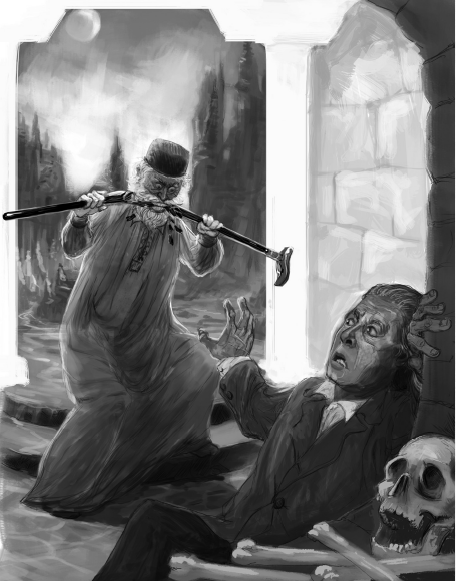
Breton’s most stalwart supporter is Louis Aragon. He’s Breton’s eyes and ears in the Dreamlands, which he reaches through flaneur-style trances: “randomly walking Parisian streets in search of mystical coincidences.” Eventually, he emerges from the streets of Paris to the streets of Hlanith. He “leads what we would call a couch-surfing existence until his 1926 relationship with steamship heiress and exhibitionist drunk Nancy Cunard .”
Aragon drifts apart from Breton following the former’s interest in Stalinism and novel-writing. Eventually, he’s picked up by Russian agents who “see the existence of the Dreamlands as an affront to materialism” and want to seal the Dreamlands off from the real world. He’s a man of action, so he’ll probably clash with the PCs at some point. In 1970, he comes out and becomes an icon of the gay liberation movement.
Dreamscaping
Dreamscaping is the primary weird power that surrealists can use. They decide something happens in the Dreamlands and it happens. There’s never a flashy transition. Instead, the shaping follows the dream-trope of something looking one way, and then it suddenly looks like something else (which it always has been.) Instability (your power stat) is behind it all. More on that soon. Since Instability isn't the most... stable source of power, any change you makes has the chance of having broad consequences, rippling across the Dreamlands.
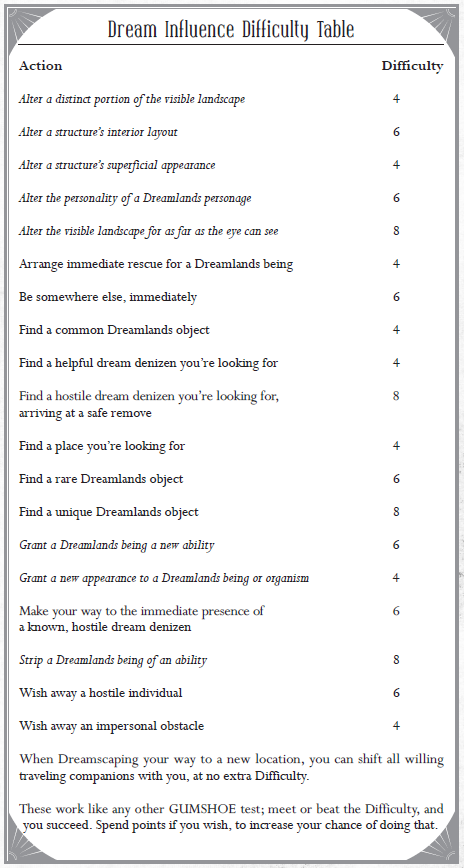
The book waffles back and forth on whether the Dreamlands create humanity’s dreams or are shaped by them. It’s best to think of the pair as interrelated. Changes made in one place will impact the other place. However, in practice, the text doesn’t provide much guidance for how changing the Dreamlands impacts the waking world. The only concrete examples I can find are in the sample adventure, when killing a spirit in the Dreamlands kills a man in reality, and where broad GM impulse rules:
Dreamhounds of Paris posted:
Salt waking sequences with vignettes, inspired by historical events in the character bios or extrapolated from them, reinforicing the theme of psychic revolution. These remind the players that their PCs really do want to alter mankind's psychology, away from obedience and authority and toward freedom and justice, through their art.
That's pretty neat, but what does that look like? Much more time is spent explaining how the Dreamlands change when surrealists run amok. When the surrealist era begins, the Dreamlands look like they do in the works of Lovecraft and Dunsany. Later entries will explain the default way they change over the campaign.
Instability
Instability is disciplined madness. It allows its bearers to explode hegemonic assumptions about art, partake in meaningful automatic writing, and shape the dreams. If you ever run out of Instability, you can no longer artistically innovate. You can mechanically repeat your old work (and even make good money doing so) buthe the artistic execution will always be mediocre, at best.
Instability can be used to boost skill tests or to directly change something. However, these changes must be related to your motifs. If they aren’t listed on your character sheet, producing an actual work of art from your artist will also do the trick. There’s no mention of how this relates to player-made PCS.
If you go against the tenets of surrealism, you risk losing Instability. The key to surrealists’ power is they’re an ordered chaos. If they break Breton’s rules, then they’re just chaos. Each of the readymade PCs is able to ignore a few of these rules based on their temperaments and alliances.
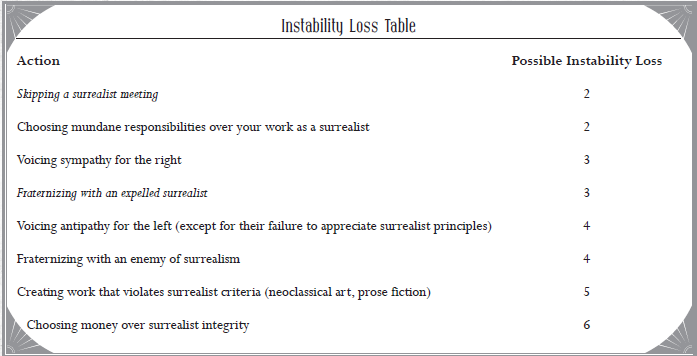
Making Art
Players automatically create works of art that they historically created. History has already judged these dice rolls: “Treat images so famous you can buy them on coffee mugs at a museum gift shop, or which are directly referenced in your character description, as masterpieces.”
All art you create gets a numerical ranking and a descriptive tag (e.g. 0: medicore, 1-3, solid.) Other artists and art historians are able to uncover this quality, but personal reasons may lead them to disagree with this numerical assessment. The general public is more wishy-washy and doesn’t get rules. In general, even the greatest masterpieces won’t receive too much attention right away. It takes time for the art world to find a consensus.
Whenever you create a surrealist masterpiece (ranking 7), the Dreamlands reacts to the demands of your art. Cities crumble, new life emerges, and old forms are cast down. The player describes what happens in a short vignette, but the work ripples out from there: “After creating a masterpiece, you may find reflections of it… whether you wanted them or not. You might paint a raven with human hands, only to be beset by them during your next visit there.”
Critical reaction to your work (visual art, theatre, or poetry--NOT novels, dance, or general music) doesn’t matter. In other words, “the dreams of the global public take power and shape from your masterpieces. ” Take a look back at some of the motifs employed by the surrealists. Maybe this isn’t such a good idea… Keep on hiding in there, Tzara.
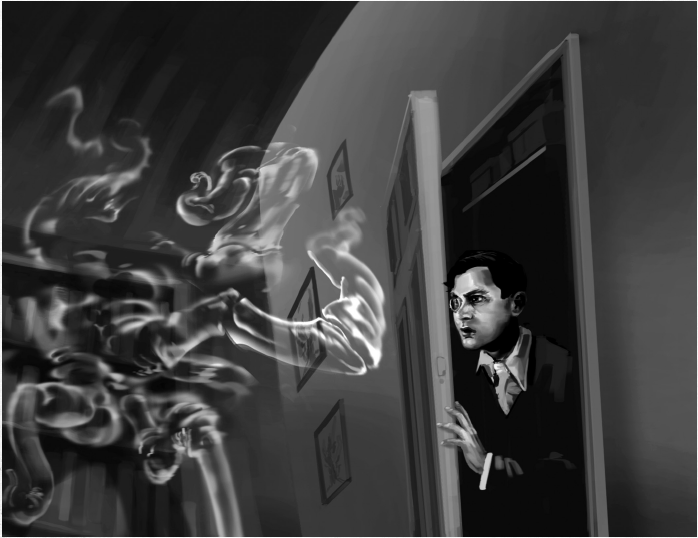
Dreamlands Physics
Distances, appearances, and the like are fluid in the Dreamlands. Spending Instability and Dreamscaping allow you to get around a lot of waking-world assumptions. Cities are located in different places every time you visit.
The Dreamlands can be visited physically (through portals like the one guarded by the ghoul Nicholas Flamel) or by tranced-up dreams.
If dreamers are hurt in the Dreamlands, they lose Instability instead of Health. Physical entrants take Health damage. If a dreamer’s physical body dies while dreaming, the dream-form may unhinge from the body and live in the Dreamlands. The dream-form’s attitudes and personality are frozen at the time of death. They can haunt dreams, go on wacky dream adventures, etc.
As characters lose Instability in the Dreamlands, their dream-forms start to break apart. Enough Instability loss and they wake up (and have to make a Stability/Sanity test) or suffer oneiric death. That’s how you get hollowed out shells, unable to innovate, create, or dream. Lousy Sex Hitler.
Resting in the Dreamlands restores Instability. Alternately, you can experience psychically destabilizing situations in the waking world. After encountering something that shatters your perceptions of an ordered reality, by flirting with the howling fringe of true cosmic understanding, you get good stuff that can go back into your art. This is a good idea.
Finally, portals between the Dreamlands and the waking world can be used to pull off correspondence shenanigans. If a dreamer in Japan (or anywhere else) enters the Dreamlands and has his dream-form walk to the oeneric side of Nicholas Flamel’s portal, his dream-form can physically enter the world of Paris. This is how worldwide PCs can jump into waking-world scenes.
Next time: Paris